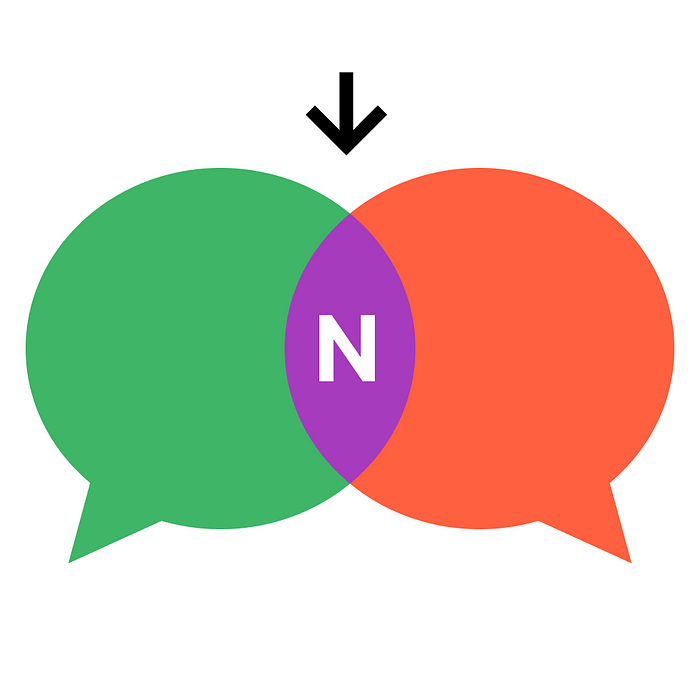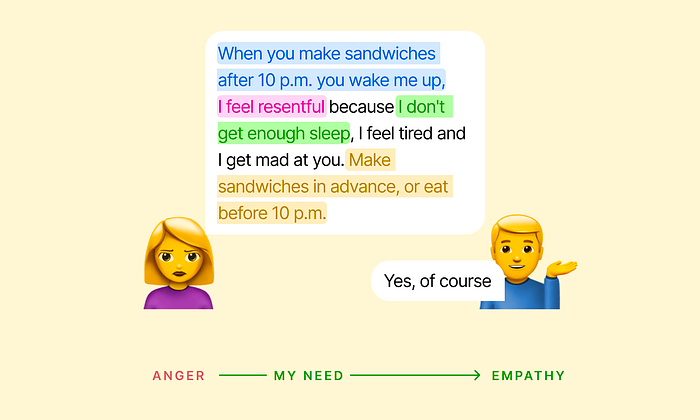Nonviolent Communication (summary+trainer)

What this book is about
This book is about conflict resolution techniques at home, at work, in a bar, in a cab, and anywhere else. Its author has even helped solve conflicts between countries using this technique.
The main problem the book reveals is that people don’t realize the need they forgot to satisfy. The author describes a specific algorithm for how to properly express your anger and respond to the anger of others. After using these tips, you can reduce the number of conflicts, and after regular practice, most conflicts will be stopped before they even begin.
Main ideas
What do I do when I feel anger?
Picture the situation. Son likes to snack late at night. He makes noise in the kitchen and wakes up his mother, who goes to bed early to get to work. Several times she woke up broken in the morning, and one day she snapped at her son, “Stop eating at night, you’ll be fat.”
Because she had been building up her anger for a long time, it began to interfere with her ability to express her needs. Because of the anger, she was unable to express her request, and she simply ruined her relationship with her son, and probably added another complex to him: a fear of being fat.

If she had read the book, she would have used a better request:
- Described her observation with a fact: “Every night” → “When you make sandwiches after 10 p.m., you wake me up.”
- Described her emotion: “I feel annoyed”. When we name our emotions and experiences, the person will be more receptive to us.
- Communicated a need: “You’re going to be fat” → “I need to sleep in order to be productive at work.”
- Communicated an expected action: “Stop eating” → “Make sandwiches in advance.”

What do I do when people are anger at me?
When we do not meet the needs of our surroundings, they accumulate anger and a quarrel occurs. Quarrels occur because anger prevents the other person from articulating the request correctly, so it needs to be clarified. For example, a mother yells at her son, “Stop eating every night, you’re going to be fat.” The son gets angry, as he is offended by this and can continue the argument: “Leave me alone.”
If the son had read the book, he probably would have helped his mother formulate the request:
- Asked about a fact that violates a need: “Is this your reaction to me being fat or because I’m disturbing your sleep?”
- Asked about the emotion: “Do you feel annoyed?”
- Clarified the need: “Am I disturbing your sleep?”
- Clarified the expected action: “Do you want me to be quiet in the kitchen after 10 p.m.?”

What do I do when I force myself?
In order to get out of conflict situations, it is necessary to correctly identify the need. To do this, we have to start by identifying our own needs.
We resist any pressure, whether it is a mother who has accused us of overeating or we have forced ourselves to do something.
For example, my son forced himself not to get fat, but at one point snapped and ate late at night. If you break your promise to yourself once — that’s okay, you have to keep on with the task at hand. But the son took his mistake as a defeat, and began to overeat even more because of the experience. Most likely, he began to overeat even more because he set himself a strict task: “I must.”
If my son had read the book, he would have identified his need:
- Changed the wording: “I must.” →“I choose.”
- Defined why he wanted to fulfill his goal: “Because I want to be healthy and confident.”

How to apply it to life
I understand how difficult it is to incorporate Nonviolent Communication into my life. This is because in moments of anger it is difficult to remember the algorithm and analyze your own and others’ needs. To that end, I created a simulator to help you understand your needs and practice dealing with old conflicts.
Chief Editor: Evgeniy Zlatov








